Yaesu FT-7900R User Manual
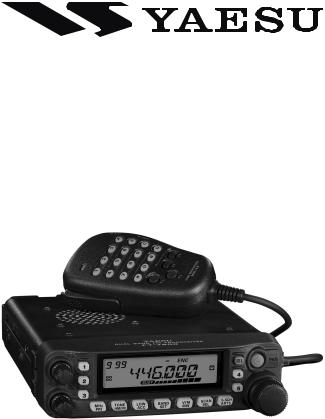
DUAL BAND FM TRANSCEIVER
FT-7900R
OPERATING MANUAL
VERTEX STANDARD CO., LTD.
4-8-8 Nakameguro, Meguro-Ku, Tokyo 153-8644, Japan
VERTEX STANDARD
US Headquarters
10900 Walker Street, Cypress, CA 90630, U.S.A.
YAESU UK LTD.
Unit 12, Sun Valley Business Park, Winnall Close
Winchester, Hampshire, SO23 0LB, U.K.
VERTEX STANDARD HK LTD.
Unit 5, 20/F., Seaview Centre, 139-141 Hoi Bun Road,
Kwun Tong, Kowloon, Hong Kong
VERTEX STANDARD (AUSTRALIA) PTY., LTD.
Normanby Business Park, Unit 14/45 Normanby Road Notting Hill 3168, Victoria, Australia

Contents
FT-7900R Quick Reference Guide ................... |
i |
Introduction ...................................................... |
1 |
Specifications .................................................... |
2 |
Accessories & Options ...................................... |
3 |
Supplied Accessories ..................................... |
3 |
Optional Accessories ...................................... |
3 |
Installation ........................................................ |
4 |
Preliminary Inspection ................................... |
4 |
Installation Tips .............................................. |
4 |
Safety Information .......................................... |
5 |
Antenna Considerations ................................. |
6 |
Mobile Installation ......................................... |
8 |
Mobile Power Connections ........................ |
9 |
Mobile Speakers ......................................... |
9 |
Base Station Installation .......................... |
10 |
AC Power Supplies .................................. |
10 |
Packet Radio Terminal Node Controller ..... |
10 |
Front Panel Controls & Switches .................. |
12 |
Side Panel Connection & Knob ..................... |
14 |
LCD .............................................................. |
14 |
Rear Panel Connections ................................. |
15 |
MH-48A6J Microphone ................................... |
16 |
MH-42B6JS Microphone .................................. |
18 |
Basic Operation .............................................. |
20 |
Turning the Transceiver On and Off ............ |
20 |
Adjusting the Audio Volume Level and |
|
Squelch Setting ........................................ |
20 |
Selecting the Operating Band ....................... |
20 |
Frequency Navigation .................................. |
21 |
Transmission ................................................ |
22 |
Changing the Transmitter Power Level ... |
22 |
Advanced Operation ...................................... |
23 |
Lock Feature ................................................. |
23 |
Keyboard Beeper .......................................... |
23 |
Display Brightness ....................................... |
24 |
RF Squelch ................................................... |
24 |
Channel Step Selection ................................ |
25 |
Receiving Mode Selection ........................... |
25 |
Repeater Operation ........................................ |
26 |
Repeater Shifts ............................................. |
26 |
Automatic Repeater Shift (ARS) .................. |
26 |
Manual Repeater Shift Activation ................ |
27 |
Changing the Default Repeater Shift ....... |
27 |
CTCSS/DCS Operation.................................. |
28 |
CTCSS Operation ......................................... |
28 |
DCS Operation ............................................. |
29 |
Tone Search Scanning .................................. |
30 |
Split Tone Operation .................................... |
31 |
Memory Operation ......................................... |
32 |
Regular Memory Channel Operation ........... |
33 |
Memory Storage ....................................... |
33 |
To Append an Alpha-numeric “Tag” |
|
to a Memory ......................................... |
33 |
Storing Independent |
|
Transmit Frequencies (“Odd Splits”) ..... |
34 |
Memory Recall ......................................... |
35 |
Memory Offset Tuning ............................ |
35 |
Deleting Memories ................................... |
36 |
HOME Channel Memory ......................... |
36 |
Memory Bank Operation ......................... |
38 |
Memory Only Mode ................................. |
39 |
Hyper Memory Channel Operation .............. |
40 |
Hyper Memory Storage ............................ |
40 |
Hyper Memory Recall .............................. |
40 |
Weather Broadcast Channel Operation ........ |
41 |
Scanning .......................................................... |
42 |
Setting the Scan-Resume Technique ............ |
42 |
VFO Scanning .............................................. |
43 |
Memory Scanning ........................................ |
44 |
How to Skip (Omit) a Channel |
|
During Memory Scan Operation .............. |
44 |
Preferential Memory Scan ....................... |
45 |
Memory Bank Scan .................................. |
46 |
Weather Alert Scan .................................. |
46 |
Programmable (Band Limit) Memory Scan .... |
47 |
“Priority Channel” Scanning (Dual Watch) .... |
48 |
VFO Priority ............................................ |
48 |
Memory Priority ....................................... |
48 |
HOME Priority ......................................... |
48 |
WX Priority .............................................. |
49 |
Priority Revert Mode ............................... |
49 |
Smart Search ................................................... |
50 |
ARTSTM: Auto Range Transponder System ...... |
52 |
Basic ARTS Setup and Operation ................ |
52 |
ARTS Polling Time Options ........................ |
53 |
ARTS Alert Beep Option ............................. |
53 |
CW Identifier Setup ..................................... |
54 |
DTMF Autodialer Operation ........................ |
56 |
Internet Connection Feature ......................... |
58 |
Miscellaneous Settings .................................... |
60 |
Time-Out Timer ........................................... |
60 |
Automatic Power Off ................................... |
60 |
MIC Gain Control ........................................ |
61 |
Programming the Key Assignment .............. |
62 |
DCS Code Inversion .................................... |
64 |
Reset Procedure .............................................. |
65 |
Cloning ............................................................ |
66 |
Menu (“Set”) Mode ........................................ |
67 |
“Auto” Mode Preset Operating Parameters ... |
78 |

INTRODUCTION
The FT-7900R is a ruggedly-built, high quality Dual Band FM transceiver providing 50 Watts of power output on the 144 MHz Amateur band and 45 Watts on the 430 MHz Amateur band.
The high power output of the FT-7900R is produced by its RD70HVF1 Power MOS FET amplifier, with a direct-flow heat sink and thermostatically-controlled cooling fan maintaining a safe temperature for the transceiver’s circuitry.
Featuring 1055 memory channels which enable the storage of Independent Transmit Frequencies (“Odd Split”), and built-in CTCSS and DCS encoder/decoder circuits, the FT-7900R includes also provision for remote-head mounting, utilizing the optional YSK-7800 Separation Kit, which allows installation even in the most compact of cars.
Additional features include a convenient access key for Vertex Standard’s WIRES™ (WideCoverage Internet Repeater Enhancement System), a transmit Time-Out Timer (TOT), Automatic Power-Off (APO), Automatic Repeater Shift (ARS), plus Yaesu’s exclusive ARTS™ (Auto-Range Transponder System) which “beeps” the user when you move out of communications range with another ARTSTM equipped station. And an RF squelch circuit allows the owner to set the squelch to open at a programmable setting of the S-Meter, thus reducing guesswork in setting the squelch threshold.
We recommend that you read this manual in its entirety, so as to understand fully the many features of your new FT-7900R transceiver.
FT-7900R OPERATING MANUAL |
1 |

SPECIFICATIONS
General
Frequency Range: |
RX: |
108.000 - 520.000 MHz, |
|
|
700.000 - 999.990 MHz (Cellular Blocked) |
|
TX: |
144.000 - 148.000 MHz or 144.000 - 146.000 MHz, |
Channel Steps: |
|
430.000 - 450.000 MHz or 430.000 - 440.000 MHz |
5/10/12.5/15/20/25/50/100 kHz |
||
Modes of Emission: |
F3E, F2D, F2A |
|
Antenna Impedance: |
50 Ohms, unbalanced (Antenna Duplexer built-in) |
|
Frequency Stability: |
±5 ppm @ 14 °F ~ +140 °F (–10 °C ~ +60 °C) |
|
Operating Temperature Range: –4 °F ~ +140 °F (–20 °C ~ +60 °C) |
||
Supply Voltage: |
13.8 VDC (±15 %), negative ground |
|
Current Consumption (Approx.): RX: 0.5 A (Squelched) |
||
|
TX: |
8.5 A (144 MHz, 50 W) |
Case Size (W x H x D): |
|
9 A (430 MHz, 45 W) |
5.5” x 1.6” x 6.6” (140 x 41.5 x 168 mm) |
||
Weight (Approx.): |
(w/o knobs & connectors) |
|
2.2 lb. (1 kg) |
||
Transmitter
Output Power: |
50/20/10/5 W (144 MHz) |
Modulation Type: |
45/20/10/5 W (430 MHz) |
Variable Reactance |
|
Maximum Deviation: |
±5 kHz, ±2.5 kHz |
Spurious Radiation: |
At least –60 dB below |
Microphone Impedance: |
2 kΩ |
DATA Jack Impedance: |
10 kΩ |
Receiver
Circuit Type: |
Double-conversion superheterodyne |
|
Intermediate Frequencies: |
45.05 MHz/450 kHz |
|
Sensitivity: |
0.8 |
μV (TYP) for 10 dB SN (108 - 137 MHz, AM) |
|
0.2 |
μV for 12 dB SINAD (137 - 150 MHz, FM) |
|
0.25 μV for 12 dB SINAD (150 - 174 MHz, FM) |
|
|
0.3 |
μV (TYP) for 12 dB SINAD (174 - 222 MHz, FM) |
|
0.25 μV (TYP) for 12 dB SINAD (222 - 300 MHz, FM) |
|
|
0.8 |
μV (TYP) for 10 dB SN (300 - 336 MHz, AM) |
|
0.25 μV for 12 dB SINAD (336 - 420 MHz, FM) |
|
|
0.2 |
μV for 12 dB SINAD (420 - 520 MHz, FM) |
|
0.4 |
μV (TYP) for 12 dB SINAD (800 - 900 MHz, FM) |
Squelch Sensitivity: |
0.8 μV (TYP) for 12 dB SINAD (900 - 999.99 MHz, FM) |
|
Better than 0.16 μV |
||
Selectivity (–6dB/–60dB): |
12 kHz/30 kHz |
|
Maximum AF Output: |
2 W @ 8 Ω for 10% THD |
|
AF Output Impedance: |
4-16 Ω |
|
Specifications are subject to change without notice, and are guaranteed within the 144 and 430 MHz amateur bands only. Frequency ranges will vary according to transceiver version; check with your dealer.
2 |
FT-7900R OPERATING MANUAL |

|
ACCESSORIES & OPTIONS |
|
|
SUPPLIED ACCESSORIES |
|
Microphone MH-48A6J ...................................................................................................... |
1 |
|
Mobile Mounting Bracket MMB-36 .................................................................................. |
1 |
|
DC Power Cord w/Fuse (T9021715) .................................................................................. |
1 |
|
Spare Fuse 15 A (Q0000081) ............................................................................................. |
2 |
|
Operating Manual ............................................................................................................... |
1 |
|
Warranty Card |
..................................................................................................................... |
1 |
|
OPTIONAL ACCESSORIES |
|
MH-48A6J |
DTMF MicrophoneÚ1 |
|
MH-42B6JS |
Hand MicrophoneÚ1 |
|
YSK-7800 |
Separation Kit |
|
MEK-2 |
Microphone Extension KitÚ2 |
|
MLS-100 |
High-Power External Speaker |
|
FP-1023 |
AC Power Supply (25A: USA only) |
|
FP-1030A |
AC Power Supply (25A) |
|
CT-39A |
Packet Interface Cable |
|
Availability of accessories may vary. Some accessories are supplied as standard per local requirements, while others may be unavailable in some regions. Consult your Yaesu dealer for details regarding these and any newly-available options Connection of any non-Yaesu- approved accessory, should it cause damage, may void the Limited Warranty on this apparatus.
Ú1: If you replace the microphone from the MH-48A6J to MH-42B6JS or vice versa, change the setting of Menu #22 (MIC). See page 73 for details.
Ú2: When using the MH-48A6J or MH-42B6JS microphone in conjunction with the MEK- 2, in some cases, the programmable key functions (MH-48A6J: [P1] through [P4], MH-42B6JS: [ACC], [P], [P1], and [P2]) may operate erratically.
FT-7900R OPERATING MANUAL |
3 |

INSTALLATION
This chapter describes the installation procedure for integrating the FT-7900R into a typical amateur radio station. It is presumed that you possess technical knowledge and conceptual understanding consistent with your status as a licensed radio amateur. Please take some extra time to make certain that the important safety and technical requirements detailed in this chapter are followed closely.
PRELIMINARY INSPECTION
Inspect the transceiver visually immediately upon opening the packing carton. Confirm that all controls and switches work freely, and inspect the cabinet for any damage. Gently shake the transceiver to verify that no internal components have been shaken loose due to rough handling during shipping.
If any evidence of damage is discovered, document it thoroughly and contact the shipping company (or your local dealer, if the unit was purchased over-the-counter) so as to get instructions regarding the prompt resolution of the damage situation. Be certain to save the shipping carton, especially if there are any punctures or other evidence of damage incurred during shipping; if it is necessary to return the unit for service or replacement, use the original packing materials but put the entire package inside another packing carton, so as to preserve the evidence of shipping damage for insurance purposes.
INSTALLATION TIPS
To ensure long life of the components, be certain to provide adequate ventilation around the cabinet of the FT-7900R.
Do not install the transceiver on top of another heat-generating device (such as a power supply or amplifier), and do not place equipment, books, or papers on top of the FT-7900R. Avoid heating vents and window locations that could expose the transceiver to excessive direct sunlight, especially in hot climates. The FT-7900R should not be used in an environment where the ambient temperature exceeds +140 °F (+60 °C).
4 |
FT-7900R OPERATING MANUAL |
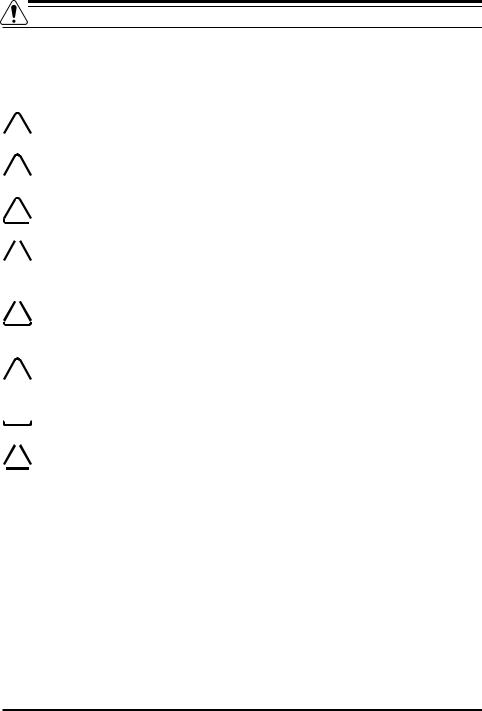
INSTALLATION
SAFETY INFORMATION
The FT-7900R is an electrical apparatus, as well as a generator of RF (Radio Frequency) energy, and you should exercise all safety precautions as are appropriate for this type of device. These safety tips apply to any device installed in a well-designed amateur radio station.
Never allow unsupervised children to play in the vicinity of your transceiver or an-

 tenna installation.
tenna installation.
Be certain to wrap any wire or cable splices thoroughly with insulating electrical

 tape, to prevent short circuits.
tape, to prevent short circuits.
Do not route cables or wires through door jambs or other locations where, through
 wear and tear, they may become frayed and shorted to ground or to each other.
wear and tear, they may become frayed and shorted to ground or to each other.
 Do not stand in front of a directional antenna while you are transmitting into that
Do not stand in front of a directional antenna while you are transmitting into that 
 antenna. Do not install a directional antenna in any location where humans or pets
antenna. Do not install a directional antenna in any location where humans or pets
may be walking in the main directional lobe of the antenna’s radiation pattern.
 In mobile installations, it is preferable to mount your antenna on top of the roof of the
In mobile installations, it is preferable to mount your antenna on top of the roof of the 
 vehicle, if feasible, so as to utilize the car body as a counterpoise for the antenna and
vehicle, if feasible, so as to utilize the car body as a counterpoise for the antenna and
raise the radiation pattern as far away from passengers as possible.
During vehicular operation when stopped (in a parking lot, for example), make it a

 practice to switch to Low power if there are people walking nearby.
practice to switch to Low power if there are people walking nearby.  Never wear dual-earmuff headphones while driving a vehicle.
Never wear dual-earmuff headphones while driving a vehicle.
 Do not attempt to drive your vehicle while making a telephone call on an autopatch
Do not attempt to drive your vehicle while making a telephone call on an autopatch 
 using the DTMF microphone. Pull over to the side of the road, whether dialing manu-
using the DTMF microphone. Pull over to the side of the road, whether dialing manu-
ally or using the auto-dial feature.
FT-7900R OPERATING MANUAL |
5 |

INSTALLATION
ANTENNA CONSIDERATIONS
The FT-7900R is designed for use with antennas presenting an impedance of near 50 Ohms at all operating frequencies. The antenna (or a 50 Ohm dummy load) should be connected whenever the transceiver is turned on, to avoid damage that could otherwise result if transmission occurs accidentally without an antenna.
Ensure that your antenna is designed to handle 50 Watts of transmitter power. Some mag- netic-mount mobile antennas, designed for use with hand-held transceivers, may not be capable of withstanding this power level. Consult the antenna manufacturer’s specification sheet for details.
Most all FM work is performed using vertical polarization. When installing a directional antenna such as a Yagi or Cubical Quad, be certain to orient it so as to produce vertical polarization, unless you are engaged in a special operating situation where horizontal polarization is used. In the case of a Yagi antenna, orient the elements vertically for vertical polarization; for a Cubical Quad, the feedpoint should be at the center of one of the vertical sides of the driven element (or at a side corner, in the case of a diamond-shaped Cubical Quad).
Note that this transceiver is designed with wide frequency coverage in the VHF/UHF spectrum. For general listening, you may wish to have a broadband antenna such as a discone available, as a directional antenna such as a Yagi will have degraded performance outside the Amateur band for which it is designed.
Excellent reference texts and computer software are available for the design and optimization of VHF and UHF antennas. Your dealer should be able to assist you with all aspects of your antenna installation requirements.
Use high-quality 50 Ohm coaxial cable for the lead-in to your FT-7900R transceiver. All efforts at providing an efficient antenna system will be wasted if poor quality, lossy coaxial cable is used. Losses in coaxial lines increase as the frequency increases, so an 8-meter-long (25’) coaxial line with under 1 dB of loss at 144 MHz may have a loss of 3 dB or more at 446 MHz; choose your coaxial cable carefully based on the installation location (mobile vs. base) and the overall length of the cable required (for very short runs of cable in a mobile installation, the smaller, more flexible cable types may be acceptable).
6 |
FT-7900R OPERATING MANUAL |

INSTALLATION
ANTENNA CONSIDERATIONS
For reference, the chart below shows approximate loss figures for typically-available coaxial cables frequently used in VHF/UHF installations.
Loss in dB per 30 m (100 feet) for Selected 50-Ohm Coaxial Cables
(Assumes 50-Ohm Input/Output Terminations)
CABLE TYPE |
LOSS: 144 MHZ |
LOSS: 430 MHZ |
RG-58A |
6.5 |
> 10 |
RG-58 Foam |
4.7 |
8 |
RG-213 |
3.0 |
5.9 |
RG-8 Foam |
2.0 |
3.7 |
Belden 9913 |
1.5 |
2.9 |
Times Microwave LMR-400 |
1.5 |
2.6 |
7/8” “Hardline” |
0.7 |
1.3 |
Loss figures are approximate; consult cable manufacturers’ catalogs for complete specifications.
In outdoor installations, be certain to weatherproof all connectors thoroughly, as water entering a coaxial cable will cause losses to escalate rapidly, thus diminishing your communications effectiveness. The use of the shortest possible length of the highest quality coaxial cable that fits within your budget will ensure the best performance from your FT-7900R.
FT-7900R OPERATING MANUAL |
7 |
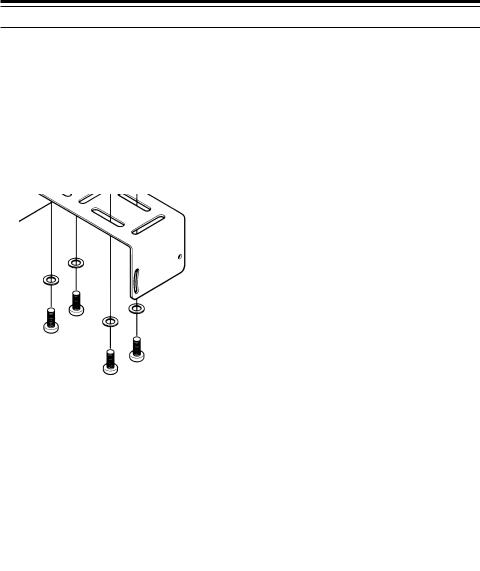
INSTALLATION
MOBILE INSTALLATION
The FT-7900R must only be installed in vehicles having a 13.8 Volt negative ground electrical system. Mount the transceiver where the display, controls, and microphone are easily accessible, using the supplied MMB-36 mounting bracket.
The transceiver may be installed in almost any location, but should not be positioned near a heating vent nor anywhere where it might interfere with driving (either visually or mechanically). Make sure to provide plenty of space on all sides of the transceiver so that air can flow freely around the radio’s case. Refer to the diagrams showing proper installation procedures.
|
|
|
|
|
|
|
|
|
|
|
|
|
|
|
|
|
|
|
|
8 |
|
|
FT-7900R OPERATING MANUAL |
|
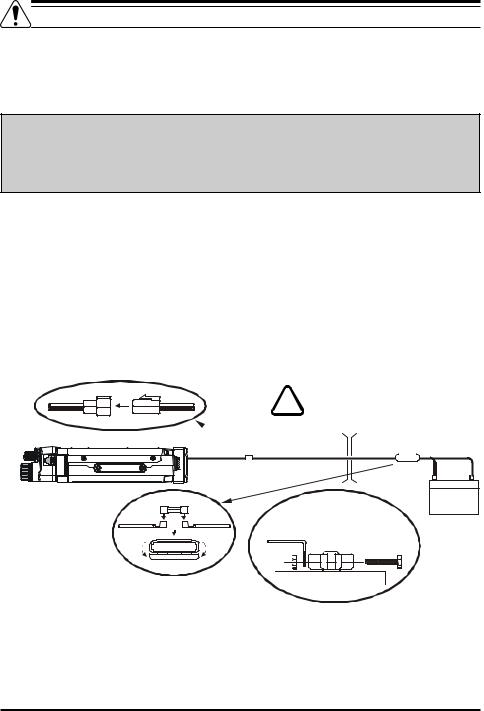
INSTALLATION
MOBILE INSTALLATION
Mobile Power Connections
To minimize voltage drop and avoid blowing the vehicle’s fuses, connect the supplied DC power cable directly to the battery terminals. Do not attempt to defeat or bypass the DC cable’s fuse - it is there to protect you, your transceiver, and your vehicle’s electrical system.
Warning!
Never apply AC power to the power cable of the FT-7900R, nor DC voltage greater than 15.8 Volts. When replacing the fuse, only use a 15-A fast-blow type. Failure to observe these safety precautions will void the Limited Warranty on this product.
Before connecting the transceiver, check the voltage at the battery terminals while revving the engine. If the voltage exceeds 15 Volts, adjust the vehicle’s voltage regulator before proceeding with installation.
Connect the RED power cable lead to the POSITIVE (+) battery terminal, and the BLACK power cable lead to the NEGATIVE (–) terminal. If you need to extend the power cable, use #12 AWG or larger insulated, stranded copper wire. Solder the splice connections carefully, and wrap the connections thoroughly with insulating electrical tape.
Before connecting the cable to the transceiver, verify the voltage and polarity of the voltage at the transceiver end of the DC cable using a DC voltmeter. Now connect the transceiver to the DC cable.
|
WARNNING! |
|
|
Never remove the FUSE holders |
|
|
from the DC cable. |
|
FT-7900R |
Cabin |
Engine Room |
|
||
 Battery
Battery
RED: Positive (+)
BLACK: Negative (–)
Mobile Speakers
The optional MLS-100 External Speaker includes its own swivel-type mounting bracket, and is available from your Yaesu dealer.
Other external speakers may be used with the FT-7900R, if they present the specified 8-Ohm impedance and are capable of handling the 2 Watts of audio output supplied by the FT-7900R.
FT-7900R OPERATING MANUAL |
9 |

INSTALLATION
BASE STATION INSTALLATION
The FT-7900R is ideal for base station use as well as in mobile installations. The FT-7900R is specifically designed to integrate into your station easily, using the information to follow as a reference.
AC Power Supplies
Operation of the FT-7900R from an AC line requires a power source capable of providing at least 10 Amps continuously at 13.8 Volts DC. The FP-1023 and FP-1030A AC Power Supplies are available from your Yaesu dealer to satisfy these requirements. Other wellregulated power supplies may be used, as well, if they meet the above voltage and current specifications.
Use the DC power cable supplied with your transceiver for making power connections to the power supply. Connect the RED power cable lead to the POSITIVE (+) power supply terminal, and connect the BLACK power cable lead to the NEGATIVE (–) power supply terminal.
Packet Radio Terminal Node Controller (TNC)
The FT-7900R provides a convenient rear-panel DATA jack for easy connections to your TNC. This connector is a standard mini-DIN connector. A pre-wired connector and cable assembly option, model CT-39A, is available from your local Yaesu dealer.
The FT-7900R’s DATA jack connections are optimized for the data transmission and reception speed in use. In accordance with industry standards, the signal levels, impedances, and bandwidths are significantly different on 9600 bps as opposed to 1200 bps. If your TNC does not provide multiple lines to accommodate such optimization, you may still be able to utilize your TNC, if it is designed for multiple-radio use, by connecting the TNC “Radio 1” port to the 1200 bps lines on the FT-7900R, and the “Radio 2” port to the 9600 bps lines.
The pin connections of the Data connector are shown below.
Pin |
Label |
Note |
CT-39A Wire Color |
|
|
|
Packet Data Input |
|
|
1 |
PKD |
Impedance: 10 kΩ, |
Brown |
|
(DATA IN) |
Maximum Input Level: 40 mV p-p for 1200 bps |
|||
|
|
|||
|
|
2.0 Vp-p for 9600 bps |
|
|
2 |
GND |
Signal Ground |
Red |
|
3 |
PTT |
Gound to Transmit |
Orange |
|
4 |
RX9600 |
9600 bps Packet Data Output |
Yellow |
|
Impedance: 10 kΩ, Maximum Output: 500 mV p-p |
||||
|
|
|
||
5 |
RX1200 |
1200 bps Packet Data Output |
Green |
|
Impedance: 10 kΩ, Maximum Output: 300 mV p-p |
||||
|
|
|
||
6 |
PKS |
Squelch Control |
Blue |
|
(SQL) |
Squelch Open: +5 V, Squelch Close: 0 V |
|||
|
|
|||
|
|
|
|
10 |
FT-7900R OPERATING MANUAL |
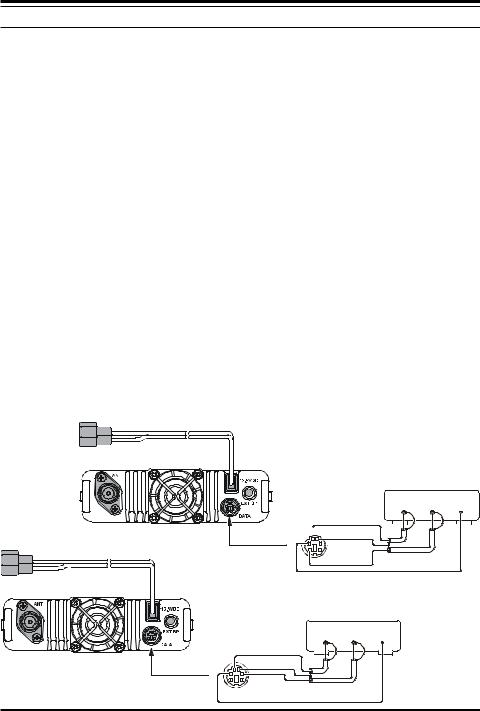
INSTALLATION
BASE STATION INSTALLATION
Note that 9600 bps packet transmit-deviation adjustment is very critical to successful operation, and can only be accomplished using a calibrated deviation meter (such as that found on an FM Service Monitor used in a communications service center). In most cases, the Packet Data Input level (set via a potentiometer inside the TNC) must be adjusted to provide a deviation of ±2.75 kHz (±0.25 kHz). Check with your packet node’s sysop if you have any questions about the appropriate deviation level for your network. Note also that high throughput on 9600 bps frequently requires strong signals, so you may wish to consider the use of a directional antenna such as a Yagi for communication with high-speed packet nodes.
The setting of the 1200 bps Packet Data Input level is much less critical than it is at 9600 bps, and satisfactory adjustment to the optimum (±2.5 ~ ±3.5 kHz) deviation can usually be done “by ear” by adjusting the TNC’s 1200 bps TX Audio Level potentiometer so that the outgoing packets (as monitored on a separate VHF or UHF receiver) are approximately the same level as (A) the DTMF tones or (B) the 1750 Hz Burst tone produced using the microphone.
Finally, note that the Menu (“Set”) mode allows you to set the Packet data rate (1200 or 9600 bps) independently for each band. If you have trouble getting your FT-7900R to respond correctly during packet operation, check to be certain that you do not have Menu #26 (PKT.SPD) set to the wrong data rate.
You may activate the microphone input while operating on the packet mode via the Menu #25 (PKT.MIC), if desired. Generally, we do not recommend this, as a “live” microphone’s audio input will tend to reduce throughput by interfering with the packets being transmitted by your radio.
9600 BPS PACKET SETUP
DATA |
DATA |
|
OUT |
IN |
PTT |
DATA IN
 GND
GND
DATA OUT (1200bps)
PKS
1200 BPS PACKET SETUP
DATA |
DATA |
|
OUT |
IN |
PTT |
DATA IN
GND
DATA OUT (9600bps)
PKS
FT-7900R OPERATING MANUAL |
11 |

FRONT PANEL CONTROLS & SWITCHES
 VOL Knob
VOL Knob
This control adjusts the volume level of the receiver’s audio. Clockwise rotation increases the audio level.
 SQL Knob
SQL Knob
This control sets the threshold level at which received signals (or noise) will open the squelch. It should be advanced clockwise just to the point where the noise is silenced (and the “ ” indicator on the display turns off), so as to provide the best sensitivity to weak signals.
” indicator on the display turns off), so as to provide the best sensitivity to weak signals.
 Hyper Memory Buttons ([1] ~ [5])
Hyper Memory Buttons ([1] ~ [5])
Press and hold in one of these buttons for 2 seconds to store the current total configuration of the radio into a special “Hyper” memory bank.
Press the appropriate button momentarily to recall the desired “Hyper” memory.
 [MHz(PRI)] Key
[MHz(PRI)] Key
Press this key momentarily to allow tuning in 1-MHz steps on the VFO frequency while operating on the VFO mode. In the Memory mode, press this key momentarily to allow tuning in 10 channel steps on the memory channels.
Press and hold in this key for 1/2 second to activate the Priority Channel Scanning (Dual Watch feature).
 [TONE(HM/RV)] Key
[TONE(HM/RV)] Key
Press this key momentarily to change the Tone Squelch mode: ENC (CTCSS Encoder), ENC.DEC (CTCSS Tone Squelch), or DCS (DCS) operation.
Press and hold in this key for 1/2 second to reverse the transmit and receive frequencies during split-frequency (i.e. “Repeater”) operation.
12 |
FT-7900R OPERATING MANUAL |

FRONT PANEL CONTROLS & SWITCHES
 [LOW(ACC)] Key
[LOW(ACC)] Key
Press this key momentarily to select the transmitter power output level (“LOW”, “MID2”, “MID1”, or “HIGH”).
Press and hold in this key for 1/2 second to recall the Weather Broadcast Channels. You can program the alternate (press and hold in) function of this key to another function, if desired. See page 60 for details.
 [BAND(SET)] Key
[BAND(SET)] Key
While operating on the VFO mode, press this key momentarily to toggle the operating
band as follows:
144 MHz 250 MHz 350 MHz 430 MHz 850 MHz 144 MHz ......
In the Memory mode, press this key momentarily to activate the “Memory Tune” function.
Press and hold in this key for 1/2 second to enter the Set (“Menu”) mode.
 [V/M(MW)] Key
[V/M(MW)] Key
Press this key momentarily to switch the frequency control among the VFO, Memory System, and Home channel.
Press and hold in this key for 1/2 second to transfer the VFO contents into a Memory register.
 [SCAN(SEL)] Key
[SCAN(SEL)] Key
Press this key momentarily to activate the Scanner.
Press and hold in this key for 1/2 second to select the scan mode.
 [S.SCH(ARTS)] Keys
[S.SCH(ARTS)] Keys
Press this key momentarily to activate the Smart Search feature. Press and hold in this key for 1/2 second to activate the ARTS feature.
 DIAL knob
DIAL knob
This 20-position detented rotary switch is the tuning dial for the transceiver. It is used for most tuning, memory selection, and function setting tasks on the transceiver.
 PWR (
PWR ( ) Switch
) Switch
Press and hold in this switch for 1/2 second to toggle the transceiver’s power on and off.
 [ (L)] Key
[ (L)] Key
Press this key momentarily to activate the Internet Connection Feature.
Press and hold in this key for 1/2 second to toggle the Lockout Feature “on” or “off”.
FT-7900R OPERATING MANUAL |
13 |
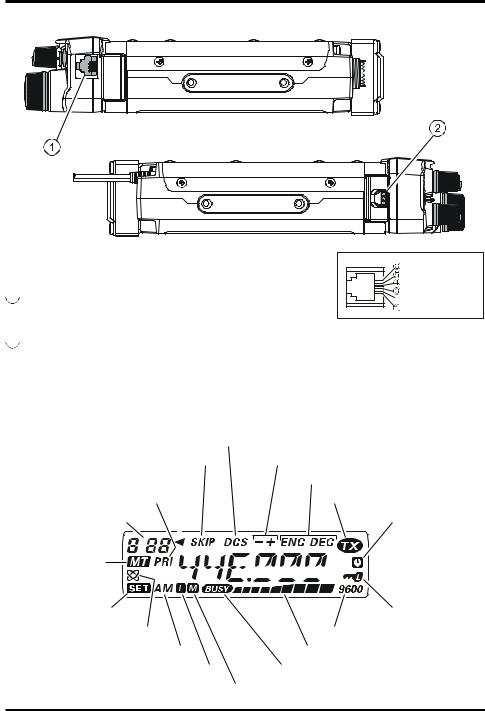
SIDE PANEL CONNECTION & KNOB
 MIC Jack (Right Side)
MIC Jack (Right Side)
Connect the supplied microphone to this jack.
: PTT
: MIC
: GND
: +9V
 : SW 1(Key Control) : SW 2 (Key Contol)
: SW 1(Key Control) : SW 2 (Key Contol)
 Front Panel Release Knob (Left Side)
Front Panel Release Knob (Left Side)
Press this knob to unlock the front panel to detachable the front panel from the transceiver’s main body for remote-head operation (requires optional YSK-7800 Separation Kit).
LCD DISPLAY
Digital Code Squelch (DCS) Operation |
|
|
Skip Memory Channel |
Repeater Shift Direction |
|
Preferential Memory Channel |
CTCSS Operation |
|
Priority Channel |
|
Transmission in Progress |
Memory Channel Number |
|
Automatic Power-Off Active |
|
|
|
Memory Tune Mode







 Operating Frequency
Operating Frequency
Menu (“Set”) Mode Active |
Keypad/DIAL Lock Active |
Internet Connection Feature Active |
9600 bps Packet Mode |
AM Mode Selected |
S- & PO Meter |
Low TX Power Selected |
BUSY Channel (or Squelch Off) |
Midium TX Power Selected |
|
14 |
FT-7900R OPERATING MANUAL |
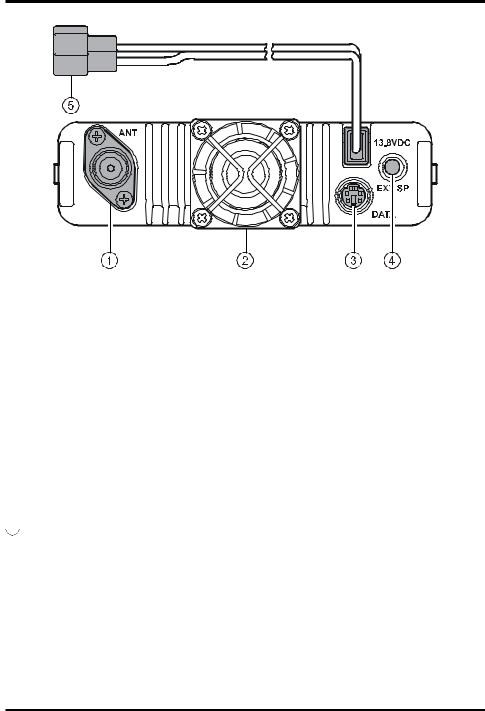
REAR PANEL CONNECTIONS
 ANT Jack
ANT Jack
Connect your antenna here, using a type-M plug (for USA version) or type-N plug (for EXP version) and coaxial cable.
 Cooling Fan
Cooling Fan
The cooling fan rotates during transmission, and for 30 seconds after the radio returns to the receive mode after transmitting.
When the RF power amplifier’s heat sink reaches a moderately high temperature, the cooling fan will rotate automatically even if the radio is in the receive mode.
 DATA Jack
DATA Jack
This 6-pin mini-DIN connector provides simple interfacing to a packet Terminal Node Controller (TNC) for 1200 bps or 9600 bps operation. The pin connections are shown on page 10.
 EXT SP Jack
EXT SP Jack
This 2-conductor, 3.5-mm mini phone jack provides audio output for an optional speaker. The optimum load impedance is 8 Ohms. Inserting a plug into this jack disables the audio path to the transceiver’s internal speaker.
 13.8V DC Cable Pigtails
13.8V DC Cable Pigtails
This is the DC power supply connection for the transceiver. Use the supplied DC cable to connect this pigtail to the car battery or base station DC power supply capable of at least 10 Amperes (continuous duty). Make certain that the Red lead connects to the Positive (+) side of the power source, and that the Black lead connects to the Negative
(–) side of the power source.
FT-7900R OPERATING MANUAL |
15 |
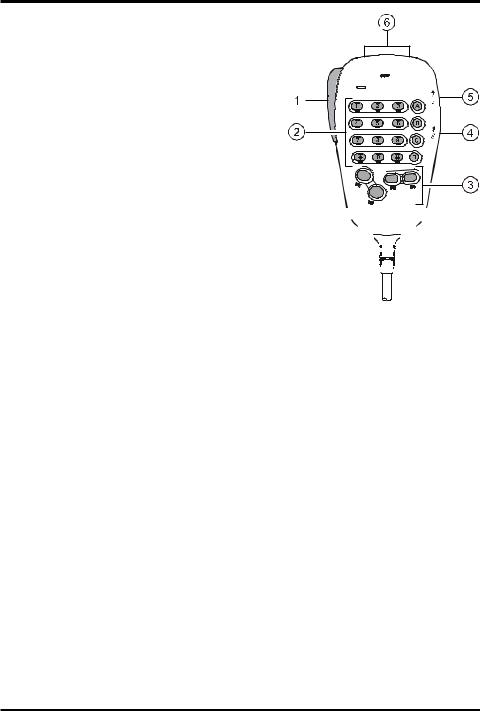
MH-48A6J MICROPHONE
 PTT Switch
PTT Switch
Press this switch to transmit, and release it to receive.
 Keypad
Keypad
These 16 keys generate DTMF tones during transmission.  In the receive mode, the numeric (0 - 9) keys can
In the receive mode, the numeric (0 - 9) keys can 
be used for direct frequency entry and/or direct numeric recall of the Memory channels and the alphabet (A - D) keys can be used for controls the transceiver, as follow: [A] Key:
Press this key momentarily to activate the Smart 



 Search feature.
Search feature. 





 Press and hold in this key for 1/2 second to activates the
Press and hold in this key for 1/2 second to activates the 





 ARTS feature.
ARTS feature. 





[B] Key:
Press this key momentarily to switch the Memory Channel display between the “Frequency” format and “Alpha-numeric Tag” format.
[C] Key:
Press this key momentarily to disable the noise squelch action, allowing you to hear very weak signals near the background noise level.
[D] Key:
Press this key momentarily to allow tuning in 1-MHz steps on the VFO frequency while operating on the VFO mode. In the Memory mode, this allows tuning in 10channel steps on the memory channels.
Press and hold in this key for 1/2 second to activate the Priority Channel Scanning (Dual Watch) feature.
 [P1]/[P2]/[P3]/[P4] Buttons
[P1]/[P2]/[P3]/[P4] Buttons
[P1] button:
This button replicates the functions of the front panel [BAND(SET)] key.
While operating on the VFO mode, press this button momentarily to toggle the
operating band as follows:
144 MHz 250 MHz 350 MHz 430 MHz 850 MHz 144 MHz ......
In the Memory mode, press this button momentarily to activate the “Memory Tune” function.
Press and hold in this key for 1/2 second to enter the Set (“Menu”) mode.
16 |
FT-7900R OPERATING MANUAL |

MH-48A6J MICROPHONE
[P2] button:
This button replicates the functions of the front panel [V/M(MW)] key.
Press this button momentarily to switch the frequency control among the VFO, Memory System, and Home channel.
Press and hold in this button for 1/2 second to transfer the VFO contents into a Memory register.
[P3] button:
This button replicates the functions of the front panel [TONE(REV)] key.
Press this button momentarily to change the Tone Squelch mode: ENC (CTCSS Encoder), ENC.DEC (CTCSS Tone Squelch), or DCS (DCS) operation.
Press and hold in this key for 1/2 second to reverse the transmit and receive frequencies during split-frequency (i.e. “Repeater”) operation.
[P4] button:
This button replicates the functions of the front panel [LOW(ACC)] key.
Press this button momentarily to select the transmitter power output level (“LOW”, “MID2”, “MID1”, or “HIGH”).
Press and hold in this key for 1/2 second to recall the Weather Broadcast Channels. You can program the [P1], [P2], [P3], and [P4] buttons for other functions, if desired. See page 62 for details.
 LAMP Switch
LAMP Switch
This switch illuminates the Microphone’s keypad.
 LOCK Switch
LOCK Switch
This switch locks out the Microphone’s buttons (except for the keypad and PTT switch).
 [UP]/[DWN] Button
[UP]/[DWN] Button
Press (or hold in) either of these buttons to tune (or scan up or down) the operating frequency or through the memory channels. In many ways, these buttons emulate the function of the (rotary) DIAL knob.
FT-7900R OPERATING MANUAL |
17 |
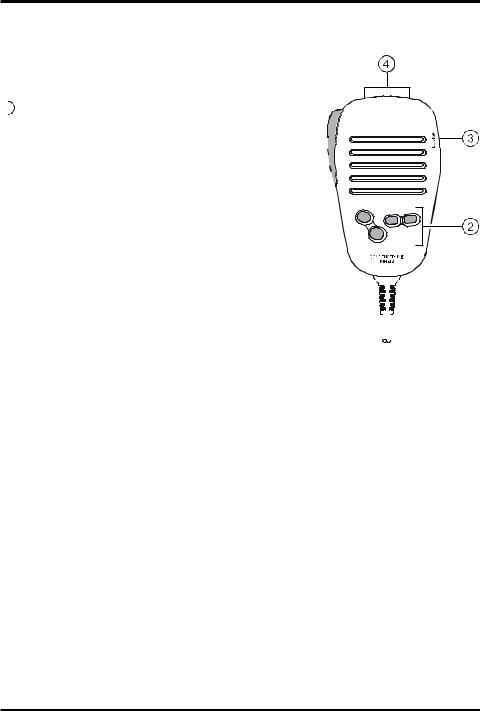
MH-42B6JS MICROPHONE
The optional MH-42B6JS is similar to the MH-48A6J, but the MH-42B6JS does not include a DTMF keypad and its illumination switch.
 PTT Switch
PTT Switch
Press this switch to transmit, and release it to receive.
 . [ACC]/[P]/[P1]/[P2] Buttons
. [ACC]/[P]/[P1]/[P2] Buttons
[ACC] button:
This button replicates the functions of the 
 front panel [BAND(SET)] key.
front panel [BAND(SET)] key.  While operating on the VFO mode, press this but-
While operating on the VFO mode, press this but- 

ton momentarily to toggle the operating band as follows:
144 MHz 250 MHz 350 MHz 430 MHz 850 MHz 144 MHz ......
|
|
In the Memory mode, press this button momentarily to |
|
|
|
|
|
|
|
|
activate the “Memory Tune” function. |
|
|
|
|
|
|
|
|
|
|
|
|
|
|
|
|
|
Press and hold in this key for 1/2 second to enter the Set |
|
|
|
|
|
|
|
|
|
|
|
|
|
||
|
|
|
|
|
|
|
||
|
|
|
|
|
|
|
||
|
|
|
|
|
|
|
||
|
|
|
|
|
|
|
||
|
|
|
|
|
|
|
||
|
|
|
|
|
|
|
||
[ |
] |
(“Menu”) mode. |
|
|
|
|
|
|
|
|
|
|
|
|
|||
|
|
|
|
|
|
|||
button: |
|
|
|
|
|
|
||
|
|
|
|
|
|
|||
P |
|
[ |
( |
|
)] |
|
||
|
|
This button replicates the functions of the front panel |
|
key. |
||||
|
|
|
V/M MW |
|
|
|||
Press this button momentarily to switch the frequency control among the VFO, Memory System, and Home channel.
Press and hold in this button for 1/2 second to transfer the VFO contents into a Memory register.
[P1] button:
This button replicates the functions of the front panel [TONE(REV)] key.
Press this button momentarily to change the Tone Squelch mode: ENC (CTCSS Encoder), ENC.DEC (CTCSS Tone Squelch), or DCS (DCS) operation.
Press and hold in this key for 1/2 second to reverse the transmit and receive frequencies during split-frequency (i.e. “Repeater”) operation.
[P2] button:
This button replicates the functions of the front panel [LOW(ACC)] key.
Press this button momentarily to select the transmitter power output level (“LOW”, “MID2”, “MID1”, or “HIGH”).
Press and hold in this key for 1/2 second to recall the Weather Broadcast Channels. You can program the [ACC], [P], [P1], and [P2] buttons for other functions, if desired. See page 62 for details.
18 |
FT-7900R OPERATING MANUAL |

MH-42B6JS MICROPHONE
 . LOCK Switch
. LOCK Switch
This switch locks out the Microphone’s buttons (except for the PTT switch).
 [UP]/[DWN] Button
[UP]/[DWN] Button
Press (or hold in) either of these buttons to tune (or scan up or down) the operating frequency or through the memory channels. In many ways, these buttons emulate the function of the (rotary) DIAL knob.
Notice: If you change the microphone from the vice versa, change the setting of Menu #22 (MIC).
MH-48A6J to the MH-42B6JS or See page 73 for details.
FT-7900R OPERATING MANUAL |
19 |
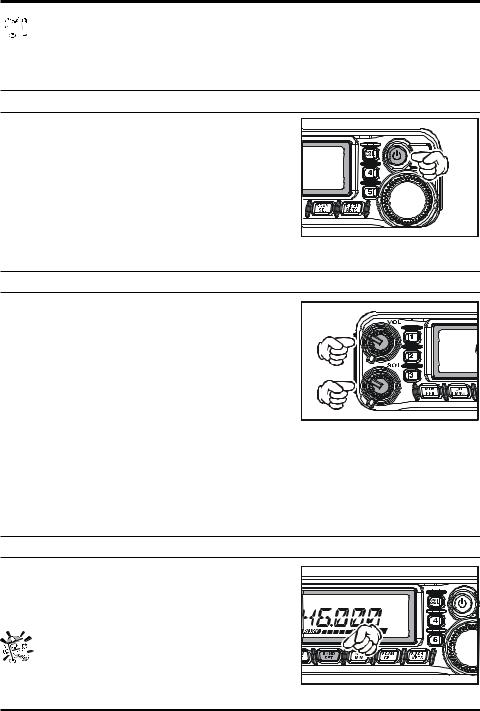
BASIC OPERATION



 Hi! I’m R. F. Radio, and I’ll be helping you along as you learn the many features
Hi! I’m R. F. Radio, and I’ll be helping you along as you learn the many features 


 of the FT-7900R. I know you’re anxious to get on the air, but I encourage you to read the “Operation” section of this manual as thoroughly as possible, so you’ll get the
of the FT-7900R. I know you’re anxious to get on the air, but I encourage you to read the “Operation” section of this manual as thoroughly as possible, so you’ll get the
most out of this fantastic new transceiver. Now. . .let’s get operating!
TURNING THE TRANSCEIVER ON AND OFF
1. To turn the transceiver on, press and hold in the PWR ( ) switch for 1/2 second.
) switch for 1/2 second.
When you turn on the FT-7900R, the current DC supply voltage is indicated on the LCD for 2 seconds. After this interval, the display will switch its normal indication of the operating frequency.
2.To turn the transceiver off, again press and hold in the PWR ( ) switch for 1/2 second.
) switch for 1/2 second.
ADJUSTING THE AUDIO VOLUME LEVEL AND SQUELCH SETTING
At first, set the SQL knob fully counter-clockwise. Now, you may rotate the VOL knob clockwise to adjust the
receiver volume for a comfortable listening level, using
the background noise as a reference.
To set the squelch, turn the SQL knob clockwise a slightly past the point where the background noise is muted. This is the point of best sensitivity to weak sig-
nals, and we recommend that you not rotate the SQL knob very much past the point where the background noise is just silenced.
A special “RF Squelch” feature is provided on this radio. This feature allows you to set the squelch so that only signals exceeding a certain S-meter level will open the squelch. See page 24 for details
SELECTING THE OPERATING BAND
Press the [BAND(SET)] key to move the operating band:
144 MHz 250 MHz 350 MHz
430 MHz 850 MHz 144 MHz ......
You may select the operating band by pressing the microphone’s [P1] key.
20 |
FT-7900R OPERATING MANUAL |

BASIC OPERATION
FREQUENCY NAVIGATION
1) Tuning Dial
Rotating the DIAL knob allows tuning in the pre-programmed steps established for the VFO frequency. Clockwise rotation of the DIAL knob causes the FT-7900R to be tuned toward a higher frequency, while counter-clockwise rotation will  lower the operating frequency.
lower the operating frequency. 
Press the [MHz(PRI)] key momentarily, then rotate the DIAL knob, to change the frequency steps to 1 MHz per step. This feature is extremely useful for making rapid
frequency excursions over the wide tuning range of the
FT-7900R.
2) Direct Keypad Frequency Entry (MH-48A6J Microphone)
The keypad of the MH-48A6J DTMF Microphone may be used for direct entry of the operating frequency.
To enter a frequency from the MH-48A6J keypad, just press the numbered digits in the proper sequence. There is no “Decimal point” key on the MH-48A6J keypad.
Examples: To enter 146.480 |
MHz, press |
[ |
] |
[ |
] |
[ |
] |
[ |
] |
[ |
8 |
] |
[ |
0 |
] |
|
1 |
|
4 |
|
6 |
|
4 |
|
|
|
|
||||
To enter 433.000 |
MHz, press |
[ |
] |
[ |
] |
[ |
] |
[ |
] |
[ |
0 |
] |
[ |
0 |
] |
|
4 |
|
3 |
|
3 |
|
0 |
|
|
|
|
3) Scanning
From the VFO mode, press and hold in the [SCAN(SEL)] key for 1/2 second, then rotate the DIAL knob to select the bandwidth for the VFO scanner. Now, press the [SCAN(SEL)] key momentarily to initiate scanning toward a higher frequency. The FT-7900R will stop when it receives a signal strong enough to break through the squelch threshold. The FT-7900R will then hold on that frequency according to the setting of the “Resume” mode (Menu #37 (SCAN); see page 75). See page 43 for details regarding the VFO Scan operation.
If you wish to reverse the direction of the scan (i.e. toward a lower frequency, instead of a higher frequency), just rotate the DIAL knob one click in the counter-clockwise direction while the FT-7900R is scanning. The scanning direction will be reversed. To revert to scanning toward a higher frequency once more, rotate the DIAL knob one click clockwise.
Press the [SCAN(SEL)] key (or the PTT key) again to stop scanning.



 You may also initiate the scanner by pressing and holding in the microphone’s
You may also initiate the scanner by pressing and holding in the microphone’s 


 [UP] or [DWN] key. However, in this case, the scanner will sweep frequencies only on the current band. If you would like the scanner not to be restricted to the current
[UP] or [DWN] key. However, in this case, the scanner will sweep frequencies only on the current band. If you would like the scanner not to be restricted to the current
band, you may change Menu #46 (VFO.BND) to allow the scanner to hop to the low edge of the next-highest band when the VFO frequency reaches the high end of the current band (or viceversa). See page 77 for details.
FT-7900R OPERATING MANUAL |
21 |
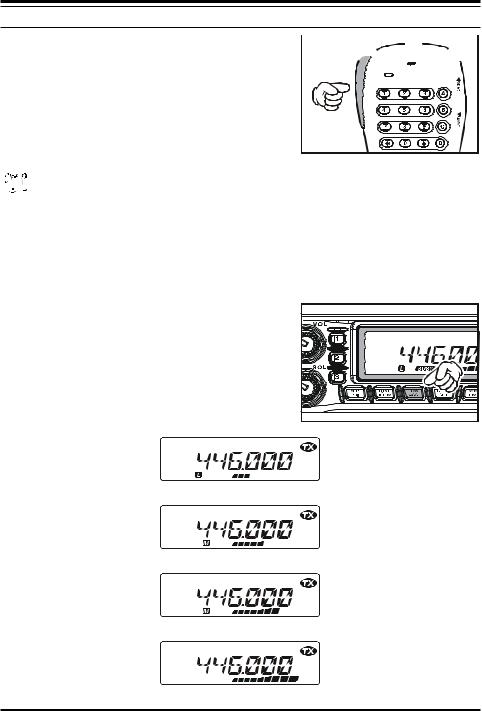
BASIC OPERATION
TRANSMISSION
To transmit, simply close the PTT (Push To Talk) switch  on the microphone when the frequency is clear. Hold
on the microphone when the frequency is clear. Hold 




the microphone approximately 25 mm (1”) from your mouth, and speak into the microphone in a normal voice level. When your transmission is complete, release the PTT switch; the transceiver will revert to the receive mode.



 When the RF power amplifier heat sink rises to a factory preset temperature, the
When the RF power amplifier heat sink rises to a factory preset temperature, the 


 transmit power level will be reduced to the “LOW” setting automatically to prevent over-heating of the radio. If you leave transmit in this condition (even in the “LOW”
transmit power level will be reduced to the “LOW” setting automatically to prevent over-heating of the radio. If you leave transmit in this condition (even in the “LOW”
mode) for an extended period of time, the radio will be forced to return to the receive mode.
Changing the Transmitter Power Level
You can select from among a total of four transmit power levels on your FT-7900R.
To change the power level, press the [LOW(ACC)] key to select one of four power settings. These power levels will be stored, in memory registers, at the time of memory storage (see page 32 for details on Memory operation).
During transmission, the Bar Graph will deflect in the display, according to the power output selected.
“LOW” POWER (5 W)
“MID 2” POWER (10 W)
“MID 1” POWER (20 W)
“HIGH” POWER (50 W: 144 MHZ, 45 W: 430 MHZ)
22 |
FT-7900R OPERATING MANUAL |
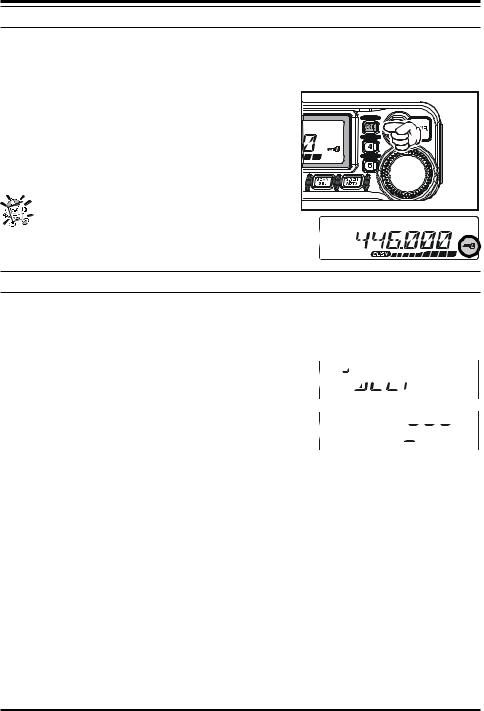
ADVANCED OPERATION
LOCK FEATURE
In order to prevent accidental frequency change or inadvertent transmission, the FT-7900R panel switches, microphone switches (except the PTT switch), and DIAL knob may be locked out.
To activate the lock feature, press and hold in the [ (L)] key for 1/2 second. The “
(L)] key for 1/2 second. The “ ” icon will appear on the LCD.
” icon will appear on the LCD.
To disable the lock feature, press and hold in the [ (L)] key for 1/2 second again.
(L)] key for 1/2 second again.
You may change the lockout combinations by
Menu #21 (LOCK). See page 73 for details.
KEYBOARD BEEPER
A key/button beeper provides useful audible feedback whenever a key/button is pressed.
If you want to turn the beep off:
1. Press and hold in the [BAND(SET)] key for 1/2 second to enter the Set mode.
2. Rotate the DIAL knob to select Menu #5 (BEEP). 












 3. Press the [BAND(SET)] key momentarily, then rotate
3. Press the [BAND(SET)] key momentarily, then rotate 




















 the DIAL knob to change the setting to “OFF.”
the DIAL knob to change the setting to “OFF.” 




 4. Press the [BAND(SET)] key momentarily to save the
4. Press the [BAND(SET)] key momentarily to save the 













 new setting, then press and hold in the [BAND(SET)]
new setting, then press and hold in the [BAND(SET)] 




















 key for 1/2 second to exit to normal operation.
key for 1/2 second to exit to normal operation. 






5. To turn the beep back on again, select “KEY” or “KEY+SC (default)” in step 3 above. KEY: The beeper sounds when you press any key.
KEY+SC: The beeper sounds when you press a key, or when the scanner stops.
FT-7900R OPERATING MANUAL |
23 |
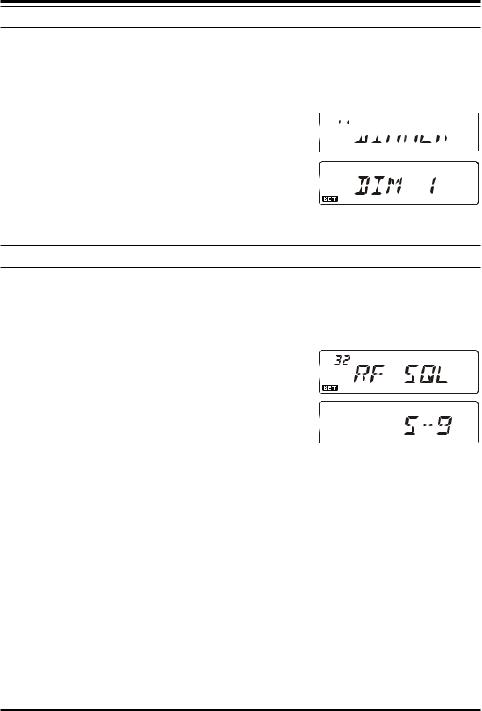
ADVANCED OPERATION
DISPLAY BRIGHTNESS
The FT-7900R display illumination has been specially engineered to provide high visibility with minimal disruption of your “night vision” while you are driving. The brightness of the display is manually adjustable, using the following procedure:
1.Press and hold in the [BAND(SET)] key for 1/2 second to enter the Set mode.
2.Rotate the DIAL knob to select Menu #11 (DIMMER). 













3.Press the [BAND(SET)] key momentarily, then rotate 




















 the DIAL knob to select a comfortable brightness level:
the DIAL knob to select a comfortable brightness level: 






DIM 1, DIM 2, DIM 3, or DIM.OFF (no illumination). 4. Press the [BAND(SET)] key momentarily to save the new setting, then press and hold in the [BAND(SET)]
key for 1/2 second to exit to normal operation.
RF SQUELCH
A special “RF Squelch” feature is provided on this radio. This feature allows you to set the squelch so that only signals exceeding a certain S-meter level will open the squelch.
To set up the RF Squelch circuit for operation, use the following procedure:
1. Press and hold in the [BAND(SET)] key for 1/2 second to enter the Set mode.
2. Rotate the DIAL knob to select Menu #32 (RF SQL). 3. Press the [BAND(SET)] key momentarily, then rotate the DIAL knob to select the desired signal strength level for the squelch threshold (OFF, S-2, S-3, S-4, S-5, S-6,
S-7, S-8, S-9, or S-FULL).
4.Press the [BAND(SET)] key momentarily to save the 





 new setting, then press and hold in the [BAND(SET)] key for 1/2 second to exit to normal operation.
new setting, then press and hold in the [BAND(SET)] key for 1/2 second to exit to normal operation.
5.Finally, rotate the SQL knob fully clockwise.
24 |
FT-7900R OPERATING MANUAL |
